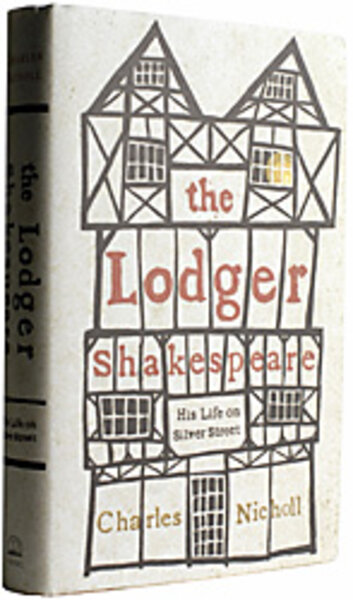Tantalizing hints of Shakespeare
Loading...
What do we really know about William Shakespeare? Apart from his writing (if it is, indeed, his writing), almost nothing. And what an unhappy thing that's been for scholars throughout the centuries.
But Charles Nicholl (British historian, biographer, and travel writer) seems quite cheerfully prepared to do much with little. One of the few solid sightings of Shakespeare in the public record (discovered only in 1909) is his appearance as a witness in a trial in 1612. There, Shakespeare gave testimony – and left behind the only words that we know are his outside of his literary output.
It's still not much. But in The Lodger Shakespeare: His Life on Silver Street, Nicholl joyously seizes on "this unexpected little window into Shakespeare's life" and turns it into an excuse for a guided tour of a tiny pocket of Shakespeare's experience.
The trial was, truly, much ado about nothing – except to those involved, a family of French immigrants named Mountjoy. They were squabbling over the question of a daughter's dowry. Shakespeare was once a boarder in the Mountjoy home and apparently (as a favor to Mrs. Mountjoy, the bride's mother and Shakespeare's landlady) had helped to persuade the Mountjoy's young live-in apprentice to marry Miss Mountjoy.
Those hoping that Shakespeare will turn out to be a star witness will be disappointed. The aggrieved son-in-law is in court because he claims the girl's father never followed through with a promised dowry of £60. Shakespeare, he says, knew of the promise because he had mentioned the dowry as an inducement to wed.
But Shakespeare says he doesn't remember the "porcion" discussed. He can only verify that he's known the family "for the space of tenne yeres or thereaboutes" and adds that he remembers the young son-in-law, Stephen Belott, as a "very good and industrious servant" who "did well and honestly behave himselfe."
And that's pretty much it. But Nicholl is tantalized by this glimpse of Shakespeare at age 40, "not from the viewpoint of literary greatness," but as he was seen as an ordinary citizen by other citizens around him. And so begins a merry chase – a sort of literary "CSI:" episode, buttressed by masses of research on Nicholl's part – after all we can learn about Shakespeare during the time he boarded with the Mountjoys (from about 1603 to 1605).
It's a bit like taking a tour of a dimly lit room with an extremely knowledgeable guide. There's almost nothing to see and yet it captivates nonetheless.
The Mountjoy's house on Silver Street no longer stands. (It was likely destroyed in the Great Fire of 1666.) Even Silver Street itself no longer exists. (German bombers destroyed it in the London Blitz of 1940.)
But Nicholl is able to capture glimpses of the neighborhood, "leafy ... with secretive walled gardens. Birdsong mingles with the noises of trade, the aroma of medicinal herbs vies with chimney-smoke, cooking-smells and cesspits."
He is also able to re-create the Mountjoys ("the industrious, quarrlesome, somewhat rackety family of immigrants with whom [Shakespeare] lodged") and the trade (the manufacturing of elaborate hats and wigs) that they brought with them from France. In their home was "the workshop with its wire-mills and twisting-wheels, and its clientele which included royalty and artistocracy as well as prostitutes and players."
Best of all, Nicholl gives us the context in which Shakespeare would have experienced all this – a London that was as sophisticated as it was squalid, and small enough that the outlines of Shakespeare's social network can be traced. (Here Nicholl is particularly knowledgeable – his other works include biographies of some Shakespeare contemporaries.)
Most of what Nicholl writes remains speculative – and yet it intrigues. A "Cordelia" (an unusual name at the time) was born around the corner in the time frame that Shakespeare worked on "King Lear." Might there be a connection?
Angelo's garden in "Measure for Measure" (another play dating from Shakespeare's Silver Street residency) is described as "circummur'd with brick,/ Whose western side is with a vineyard back'd" – much like the yards in the Mountjoy's neighborhood. Could Shakespeare's room have offered him such a view as he wrote?
"All's Well that Ends Well" (also from that period) features a young Frenchman pressed into marriage (not unlike Belott), while "King Lear" describes a daughter estranged from her father (as was the Mountjoy daughter after the squabble over her dowry). Was Shakespeare working from the world around him as wrote?
We'll never know and in truth it doesn't matter. And yet somehow it's alluring. "The Lodger Shakespeare" is a chance to almost catch a glimpse of the great man as he hurries home to his bed or strolls down the lane to the barber for a shave. For most of us, it's as close as we'll ever come to rubbing shoulders with the Bard.
• Marjorie Kehe is the Monitor's book editor. Send comments to kehem@csps.com.






